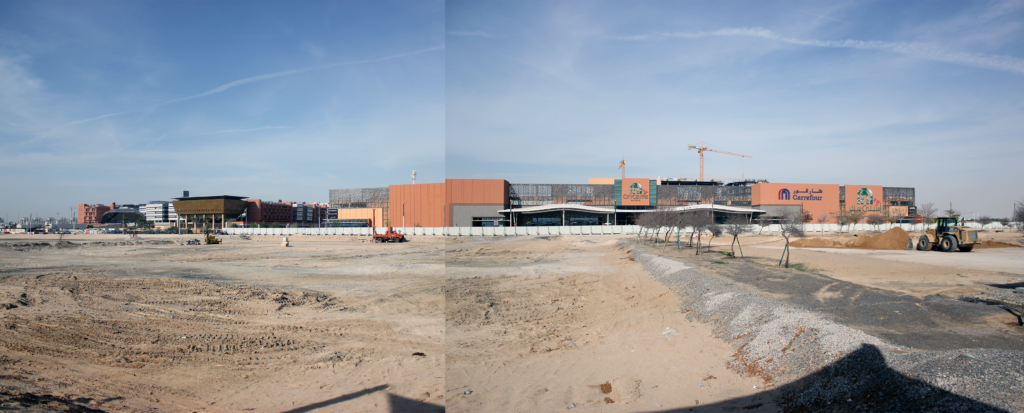
The new City Centre mall next to Masdar City anchored by the French supermarket chain Carrefour. Photograph by the author.
Spaceship in the Desert analyzes the Abu Dhabi government’s attempts to build a knowledge-based economy that centered on renewable energy and clean technology, with the goal of remaining a significant player in the energy industry well after their oil reserves ran dry or lost their financial value. In investigating this aspirational transition, the book focuses on a multi-faceted state-owned company called Masdar. In the years following its launch in 2006, Masdar (meaning “source” in Arabic) became widely known for Masdar City. Designed by the London-based architecture firm Foster + Partners to rely entirely on renewable energies, Masdar City was meant to be a showcase for the possibility of constructing a smart, zero-carbon eco-city even in the arid landscapes outside Abu Dhabi. If the project went according to plan, the city would be exported as a commodity, leading to the production of its replicas around the globe. The selected site neighbored the Abu Dhabi International Airport, the Yas Marina Formula One Circuit and the Al Ghazal Golf Course. Once completed, the city would have housed 50,000 residents and accommodated 40,000 commuters on a 600-hectare site at a cost of $22 billion.
During the time of my research, however, the only residents of Masdar City were a hundred or so graduate students who inhabited the Masdar Institute dorms. Set up and supervised by MIT’s Technology and Development Program, the energy-focused research center operated in a building within the emergent eco-city. Since the faculty and students at Masdar Institute experienced the trials and tribulations of the city project firsthand, they were fundamental to my fieldwork and remained important voices in the resulting book project.
As he sipped on his iced coffee at the Caribou Café, Michael recalled his early optimism and excitement at participating in an ambitious utopian project as a young scientist. These days Michael holds a faculty position at another university in the UAE and rarely visits his former workplace. Since 2018 the Masdar Institute has been a research unit within Khalifa University and is housed in central Abu Dhabi away from Masdar City. A new research institution named Mohamed bin Zayed University of Artificial Intelligence took over the Foster-designed Masdar Institute campus in 2019, evidence of Abu Dhabi’s shifting priorities into areas of cybersecurity and surveillance technologies.
There were no students enrolled at this university of artificial intelligence yet, which meant that the campus was calmer than it had been in 2010 and 2011. The first class of students were expected to start at MBZUAI’s Masdar City campus in September 2020. There were no guided tours, a common sight during my research, promoting Abu Dhabi’s investments in the renewable energy and clean technology sector. During our visit over coffee, scientists from other institutions who continued to use the former Masdar Institute laboratories occasionally passed through the courtyard and stopped to say hello to Michael. These passers-by explained that they sometimes saw flight attendants occupying the former Masdar Institute dorm rooms for quick overnight stays. Given its proximity to the Abu Dhabi airport, this arrangement was convenient.
Around the campus, new buildings had sprouted. Now there is a shopping mall nearby named City Centre, offering daily conveniences in its branch of the Carrefour grocery store to serve the employees of emergent institutions at Masdar City. The International Renewable Energy Agency office neighbors the Emirates Nuclear Energy Corporation headquarters, the country’s non-fossil fuel focused energy institutions leaning against each other. Some Emirati families are moving to the eco-villas on the Masdar site. A more permanent housing project for flight attendants will be built nearby. Michael told me how residents of Abu Dhabi now describe Masdar City as “a quiet suburb,” which they visit if they wish to escape the hustle and bustle of the city. In Spaceship in the Desert, I note how some Masdar Institute students imagined the future Masdar City as an Epcot-style amusement park. And yet, as Michael reminded me, Masdar City had instead merged into suburbia.
Ten years ago, many of the students and faculty I met believed that the renewable energy projects had potential. Many, including Michael, felt that they could rely on and act upon technological innovations, business models and design solutions to confront climate change. This potential did not necessarily induce a linear temporal movement toward the completion of projects in the way that was intended, but rather created an assemblage of varying, overlapping and contradictory trajectories. Of the various futures that were available to the residents of Masdar City in 2010, which ones were still possible? After some hours at the Masdar Institute campus, Michael and I climbed down a flight of stairs to the former Masdar Institute parking lot and took a taxi to downtown Abu Dhabi, leaving this question hanging in the air.
[Gökçe Günel is an assistant professor of anthropology at Rice University and author of Spaceship in the Desert: Energy, Climate Change and Urban Design in Abu Dhabi (Durham, NC: Duke University Press, 2019).]
Endnotes
[1] I thank Crown Center for Middle East Studies at Brandeis University for making this visit possible.
